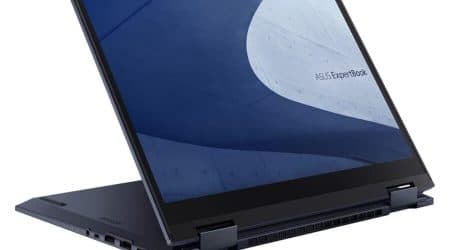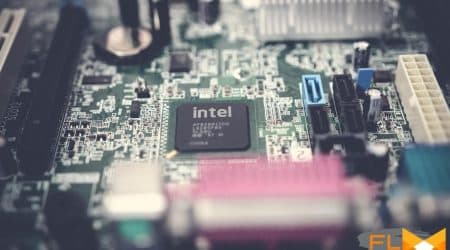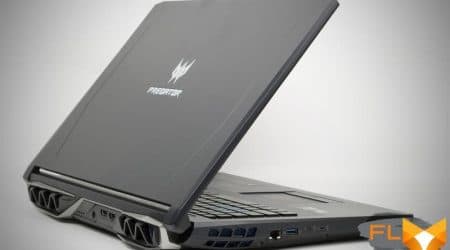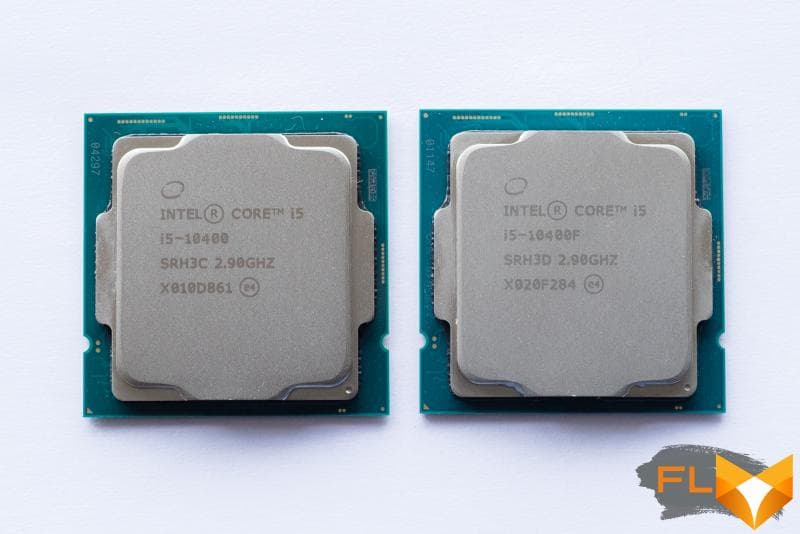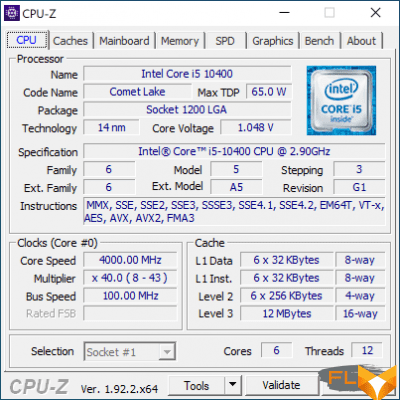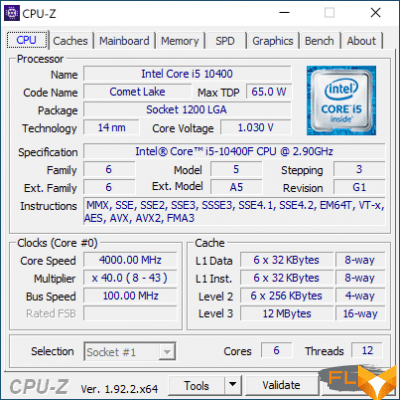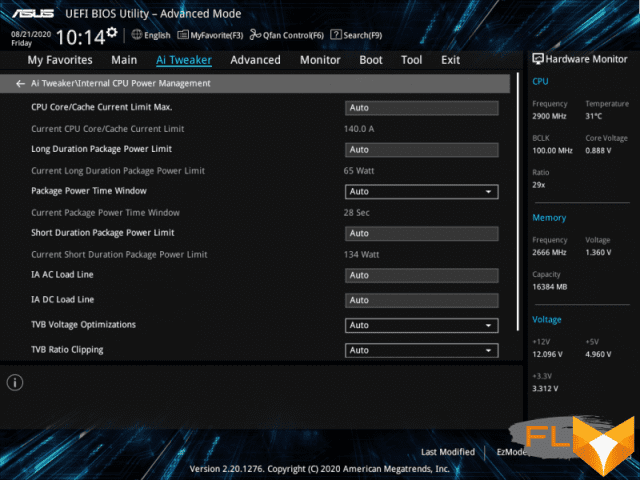


Quite a lot of time has passed since the release of Intel Comet Lake LGA1200 processors, during which we managed to publish several reviews of the most interesting representatives of the series. On our site you can read about:
- 10-core Core i9-10900K processor;
- 8-core Core i7-10700K processor;
- 6-core Core i5-10600K processor.
And here’s what’s interesting. When moving down the Comet Lake lineup, a clear trend begins to be traced: the simpler and cheaper the processor, the more attractive it seems to be in modern conditions. While the older Comet Lake turned out to be both hot and voracious, and their price-performance ratio did not allow them to be considered full-fledged competitors for modern representatives of the Ryzen series, in the case of the Core i5-10600K, everything turned out far from it. Intel’s six-core performance stood out against the background of AMD’s older six-core offering, clearly showing by its example that it is impossible to make an unambiguous conclusion about the complete superiority of processors of one or another manufacturer at the present stage.
And apparently, the most controversial situation is now developing precisely in the middle price segment, where six-core Ryzen 5 and Core i5 processors are fighting for the favor of users. Therefore, immediately after getting acquainted with the older LGA1200 six-core processor from Intel, we decided to pay attention to another processor of the same series – the younger Core i5-10400, and in particular to its modification without integrated graphics – Core i5-10400F. They, like the Core i5-10600K, have six processing cores, and at the same time their cost is about one and a half times lower and is at the level of $160-$180. As a result, the Core i5-10400 and Core i5-10400F are logically opposed to the hit of sales, the most popular processor on the market, the six-core AMD Ryzen 5 3600. And in this material, we will try to determine which of these alternatives is Core i5-10400F or Ryzen 5 3600 – better suited for an inexpensive configuration today.
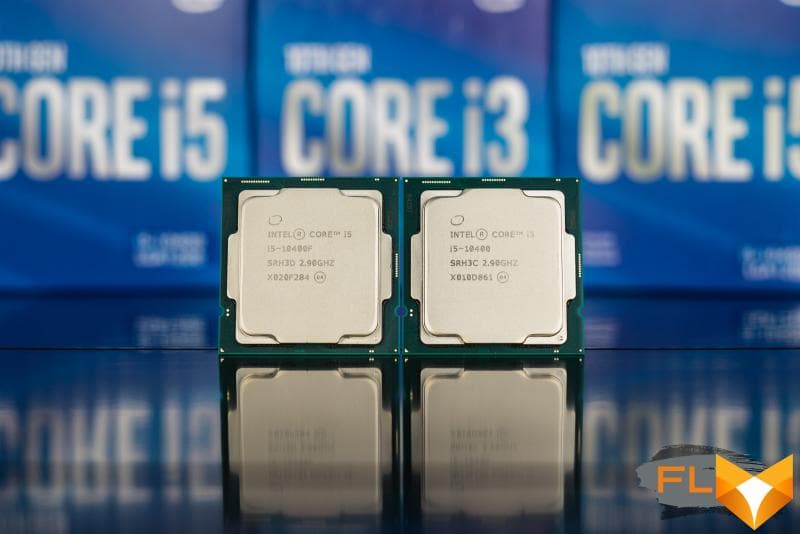
Here it would be appropriate to recall that the younger six-core processors are traditionally good at Intel. The six-core processor of the Coffee Lake Refresh generation – the Core i5-9400 – was at one time generally considered the best mid-budget model in terms of price and performance, but later AMD, having switched to the Zen 2 architecture, was able to offer a more interesting option in the face of the Ryzen 5 3600. Now the six-core family Intel has become noticeably stronger again as Hyper-Threading technology has been unlocked in Comet Lake. As a result, it turned out that the Core i5-10400F and Ryzen 5 3600 are not just competitors playing in the same price segment, but processors that are completely identical in terms of the nuclear formula, having six cores and supporting twelve threads each. This means that their comparison will at the same time make it possible to draw a more general conclusion about how the 14-nm Intel Skylake architecture, which has been invariably used in Intel desktop solutions over the past five years, looks against the background of actively progressing AMD processors.
⇡#Core i5-10400F and Core i5-10400 in detail
It’s worth saying right away that the Core i5-10400F and Core i5-10400 are almost the same thing. These processors are identical in their characteristics, and the only difference is that the version with the letter F in the name does not have integrated graphics. And in fact, the graphics core on the Core i5-10400F semiconductor chip is present, but it is hardware-locked. Intel came up with the idea of selling F-series processors last year as a measure to counter shortages, but they have caught on in the market and are now full-fledged offerings that also allow buyers to save money. For example, the Core i5-10400F is cheaper than the Core i5-10400 by a hefty $25.
Core i5-10400 (left) and Core i5-10400F (right)
In all other respects, the Core i5-10400F and Core i5-10400 are the same. These processors have a 6/12 core formula, have a 12 MB L3 cache and are designed to operate in the frequency range from the base 2.9 GHz to the maximum 4.3 GHz. Operation at the upper frequency limit is provided by the traditional Turbo 2.0 technology, no new versions of Turbo Velocity Boost (auto-overclocking depending on the temperature of the processor) and Turbo Boost Max 3.0 (auto-overclocking based on the selection of the best quality processor cores) are supported in them. But this is not news, there are no such turbo options even in the overclocker Core i5-10600K.
| Core i5-10400 | Core i5-10400F | Core i5-9400 | Ryzen 5 3600 | |
|---|---|---|---|---|
| Announcement date | April 2020 | April 2020 | October 2018 | July 2019 |
| Platform | LGA1200 | LGA1200 | LGA1151v2 | Socket AM4 |
| Technological process, mm | 14 | 14 | 14 | 7/12 |
| Cores/Threads | 6/12 | 6/12 | 6/6 | 6/12 |
| Frequency (nominal/turbo), GHz | 2.9-4.3 | 2.9-4.3 | 2.9-4.1 | 3.6-4.2 |
| L3 cache, MB | 12 | 12 | 9 | 32 |
| TDP, W | 65 | 65 | 65 | 65 |
| Memory | DDR4-2666 | DDR4-2666 | DDR4-2666 | DDR4-3200 |
| PCIe lanes | 16 × Gen3 | 16 × Gen3 | 16 × Gen3 | 20 × Gen4 |
| Integrated Graphics | UHD 630 | No | UHD 630 | No |
| Price | $182 | $157 | $182 | $199 |
However, even despite this, the Core i5-10400 looks noticeably more attractive than the Core i5-9400 for the previous LGA1151v2 platform. The new processor not only has support for Hyper-Threading technology, which was not there before, but also increased clock speeds.
| Core i5-10400 | Core i5-10400F |
If you look at the frequency layout depending on the number of working cores, it turns out that at full load, the Core i5-10400 outperforms the Core i5-9400 by 100 MHz, while offering twice as many threads.
| Maximum frequency in turbo mode, GHz | Base, GHz | ||||||
| 1 core | 2 cores | 3 cores | 4 cores | 5 cores | 6 cores | ||
| Core i5-10400 | 4,3 | 4,2 | 4,1 | 4,1 | 4.0 | 4.0 | 2.9 |
| Core i5-9400 | 4,1 | 4.0 | 4.0 | 4.0 | 3.9 | 3.9 | 2,9 |
According to Intel, the Core i5-10400 and Core i5-10400F processors are available in two versions – with a semiconductor crystal stepping Q0 and G1. The difference between them is fundamental. The Q0 stepping is the same silicon used in older Comet Lake processors. That is, these are initially ten-core crystals, in which, in the case of the Core i5-10400, four cores are hardware-locked. In fact, such processors are a rejection resulting from the production of eight- and ten-core processors. However, there is an opinion that they should be distinguished by low operating temperatures, resulting both from the large surface area of the semiconductor crystal from which heat is removed, and the fact that when assembling such processors, an effective internal thermal interface based on flux-free solder is used.
The G1 stepping in this case corresponds initially to six-core crystals, and in such processors Intel saves not only silicon, but also solder. G1 stepping processors use a polymer internal thermal interface, that is, thermal paste.
Stepping G1 (left) and Q0 (right)
It is quite easy to distinguish between versions of the Core i5-10400 and Core i5-10400F with different core steppings. Not only do they have different S-Spec markings, but they also differ in the shape of the heat-dissipating cover. For processors with G1 dies, the lid looks the same as the processors of the previous generation Coffee Lake Refresh.
| Q0 (10 cores, solder) | G1 (6 cores, thermal paste) | |
| Core i5-10400 | SRH78 | SRH3C |
| Core i5-10400F | SRH79 | SRH3D |
G1 stepping processors are currently on sale. It can even be assumed that the Q0 stepping has not yet made it into the younger six-core processors at all – we do not know anything about cases of their entry into retail sales.
And this means that you can be guaranteed to buy a six-core Comet Lake with solder only if you invest in a Core i5-10600K, which uses only Q0 stepping. However, the fact that this is so necessary can be doubted. We checked the temperature conditions of the Core i5-10400 and Core i5-10400F samples of the G1 stepping and did not find any signs of strong heating.
The graph below shows the temperatures of the Core i5-10400 and Core i5-10400F when rendering in Cinebench R20 and under load on a different number of threads and cores. The Noctua NH-U14S cooler was responsible for removing heat from the processors in this experiment.
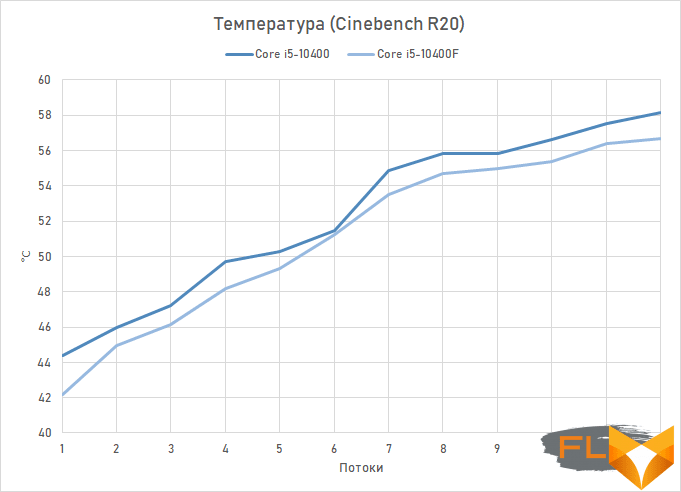
The maximum temperature of the Core i5-10400 and Core i5-10400F in this experiment was less than 60 degrees, which very clearly shows the absence of any problems with heat transfer from the semiconductor die to the CPU heat dissipation cover and further to the cooler, even though we I’m talking about G1 stepping processors with thermal paste inside.
High temperatures here simply have nowhere to come from. Intel’s junior six-core processors are distinguished by fairly moderate power consumption and heat dissipation, so the problem of strong heating is not at all a problem for them. Formally, for the Core i5-10400 and Core i5-10400F, a thermal package of 65 W is declared, and, characteristically, this is a value that is really close to reality. The following graph shows the measured consumption of the CPUs under study in Cinebench R20.
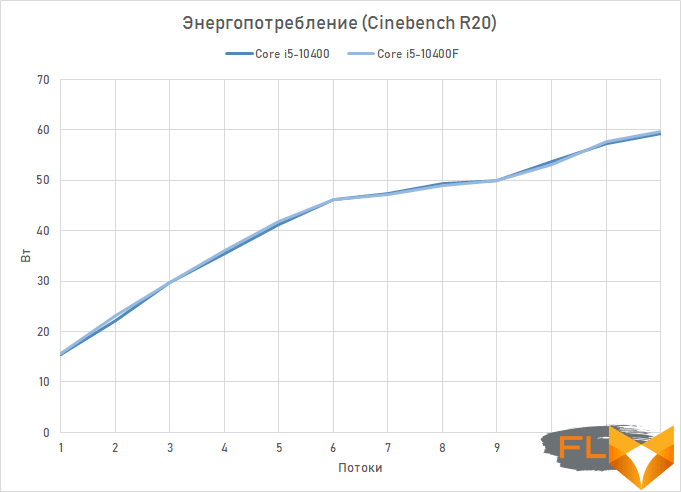
Both the Core i5-10400 and the Core i5-10400F fit well into their 65W thermal package, even with full load on all cores and threads. And this means that even in those systems where users for some reason do not enable the Multi-Core Enhancements feature (which cancels the power consumption limits), the frequency of the younger six-core Comet Lake will not be cut to meet the consumption limits. There is only one possible exception here – a heavy load using AVX2 instructions. In this case, the consumption can reach 80-85 watts, but two things must be kept in mind. First, very rare applications actually create such a load. Secondly, the PL2 limit for the Core i5-10400 and Core i5-10400F is set to 134W, which means that these processors are allowed to consume much more than 65W for 28 seconds, even if they strictly follow the official Intel specification.
Therefore, do not be surprised that the boxed cooler for the Core i5-10400 and Core i5-10400F looks like the photo below. It is enough.
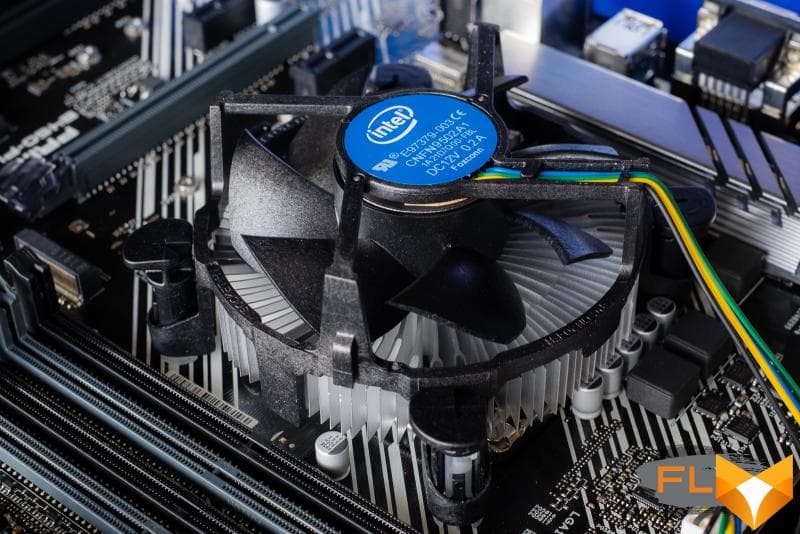
By the way, I would like to draw your attention to one more thing. In consumption tests, the Core i5-10400 and Core i5-10400F show almost identical results.
That is, the presence or absence of a functional graphics core in the processor does not affect its thermal and energy characteristics in any way if discrete graphics are installed in the system.
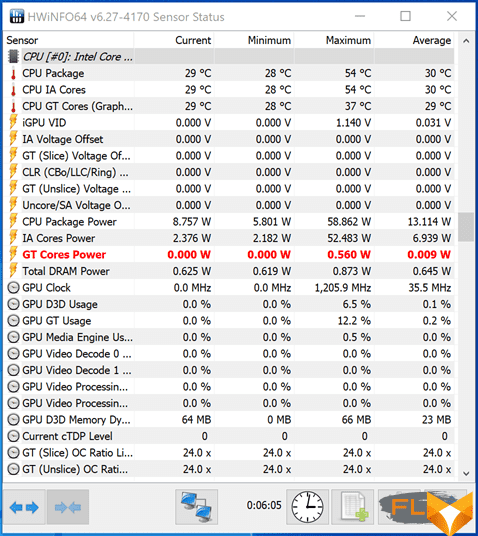
Even if the graphics UHD Graphics 630 is not disabled in the BIOS, its consumption still remains at zero without a real load.
⇡#Core i5-10400F and Core i5-10400 and B460 chipset
Talking about how good $160-$180 Intel processors are, one cannot ignore the fact that they are likely to be used in motherboards based on non-flagship chipsets. The older LGA1200-chipset Z490 is quite expensive, and the cost of even the most affordable motherboards based on it starts at $130. And this is most often too high a price for an audience focused on purchasing younger six-cores.
It is much easier in systems with Core i5-10400 and Core i5-10400F to imagine motherboards on a simpler set of logic – B460. These boards cost between $75 and $150 and seem like a logical addition to these processors.
However, you need to understand that a system built on the Z490 and on the B460 is far from the same thing. Intel is actively using chipsets to differentiate platforms by price segments, as a result of configurations with the same processors, but different motherboards can seriously differ both in capabilities and in performance. If you look at the formal chipset specifications for the LGA1200 platform, the situation seems pretty clear.
| Z490 | H470 | B460 | H410 | |
|---|---|---|---|---|
| Overclocking | Yes | No | No | No |
| DIMM per channel | 2 | 2 | 2 | 1 |
| Monitor outputs | 3 | 3 | 3 | 2 |
| PCIe 3.0 lanes | 24 | 20 | 16 | 6 |
| PCIe 3.0 x16 Bifurcation | Yes | No | No | No |
| SATA III ports | 6 | 6 | 6 | 4 |
| RAID support | Yes | Yes | Yes | No |
| USB ports | 14 | 14 | 12 | 10 |
| USB 3.2 Gen2 | 6 | 4 | 0 | 0 |
| USB 3.2 Gen1 | 10 | 8 | 8 | 4 |
| Wi-Fi | Wi-Fi 6 AX200 | Wi-Fi 6 AX200 | Wi-Fi 6 AX200 | No |
| TDP, W | 6 | 6 | 6 | 6 |
According to the official specification, the B460 lacks overclocking capabilities compared to the Z490, does not support splitting 16 PCI Express processor lines into two or three slots, is somewhat limited in the number of native PCI Express lines and in the number of USB ports, and also does not support USB 3.2 Gen 2 .
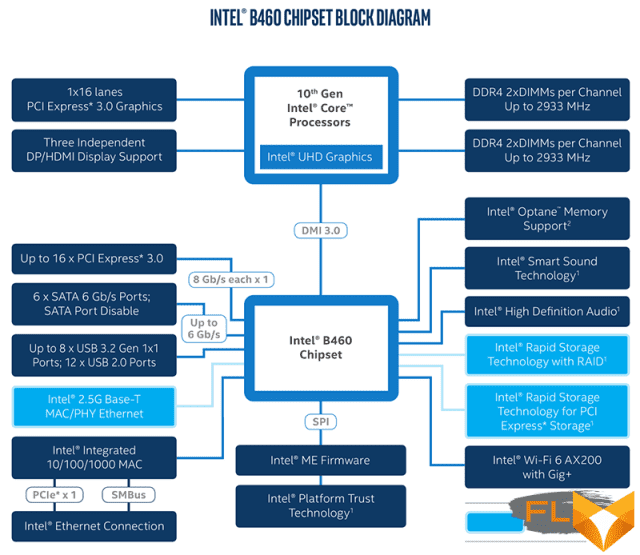
At first glance, it seems that all these losses are easy to bear, especially if you do not plan to use an unlocked K-series processor with a B460-based board. Indeed, for processors like the Core i5-10400 and Core i5-10400F, the ability to manually change the multiplication factor provided by motherboards on the Z490 is clearly useless – it still won’t work due to the limitations inherent in the processors themselves. In addition, motherboard manufacturers for their products based on the B460 have implemented various quasi-overclocking technologies that allow removing consumption limits and using processors at the maximum allowed frequency within the turbo mode. That is, boards based on the B460 can easily enable Multi-Core Enhancements in the same way as more expensive platforms based on the Z490 chip do. And this is a positive moment: such functionality is really important, including for the junior six-core processors under consideration.
Consumption limit settings on board with B460 chipset
You should not worry too much about the fact that the cheapness of boards based on the B460 turns into savings in the implementation of processor power circuits. B460-based boards, especially those of the inexpensive ones, actually have fewer phases in the power converter and often lack any decent cooling on the power elements at all. For many, this raises certain doubts about the ability of such boards to work without problems with six-core processors. However, if we talk specifically about the Core i5-10400 and Core i5-10400F, then such processors can work fine even in very simple boards. As we saw above, their consumption in most cases fits into the 65-W range, so it’s really not worth worrying about the fact that the VRM on the B460 board can’t be pulled out by the younger six-core.
As an example, we checked how the power converter feels on the ASUS Prime B460-Plus, one of the cheapest ASUS ATX boards based on the B460 chipset. On it, it is assembled according to the 3 + 1 formula and, moreover, is only partially closed by a radiator.
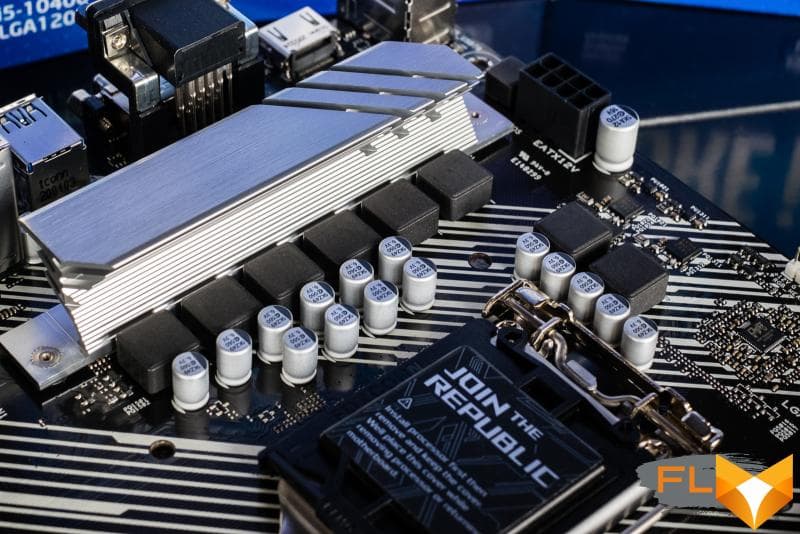
But as the experiment showed, even with a long stress load in Prime95 29.8, the power circuit on this board does not overheat, and there are no problems with the operation of the Core i5-10400 processor through its fault. As follows from the thermal image below, the maximum temperature of the VRM under continuous load does not exceed 90 degrees. Such temperatures can be considered quite acceptable, but you need to keep in mind that the younger six-core processors with a TDP of 65 W are perhaps the most powerful processors that cheap B460 boards will have no problems with.
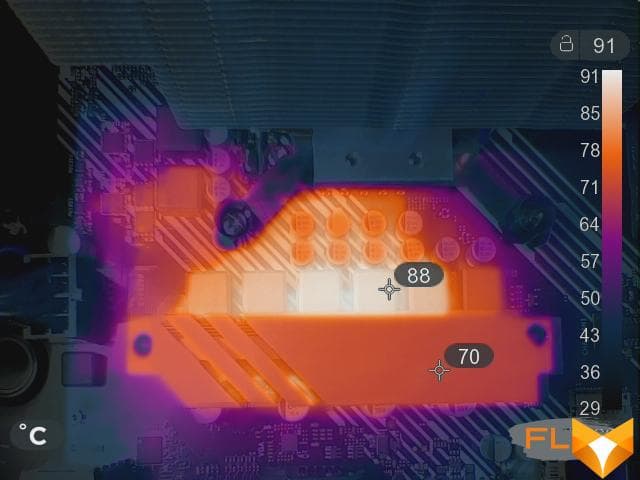
However, there is still a very sensitive flaw in motherboards based on the B460 chipset. The fact is that such boards do not support memory frequencies that go beyond the processor specifications, and this cannot be cured in any way. Thus, in B460 boards, the maximum supported memory mode for Core i9 and Core i7 processors is DDR4-2933, while Core i5 and Core i3 processors can only work with DDR4-2666. A similar ailment was also characteristic of previous Intel platforms, and now, unfortunately, it has spread to LGA1200 systems.
The forced limitation of the memory speed turns out to be a noticeable brake on the Core i5-10400 and Core i5-10400F, therefore, if possible, it is better to use these processors with Z490 boards and fast DDR4-3200 or even higher-frequency memory. This, as tests show, will allow you to get about 5-10% additional performance both in resource-intensive applications and in games. However, the price difference between the Z490 and B460 boards is still too significant for most users to heed this advice. And this is a serious problem, because it turns out that the younger six-core processors in their natural habitat are artificially slowed down by the chipset.
⇡#Description of test systems and testing methodology
The main rival for the Core i5-10400 and Core i5-10400F is, without a doubt, the Ryzen 5 3600. AMD’s junior six-core processor with the same 6/12 core formula costs about the same, although there has been a tendency to rise in price lately. But nevertheless, most users who want to build a mid-range system are faced with the choice between the Core i5-10400F and the Ryzen 5 3600.
The diagrams below show only one processor from a pair of Core i5-10400 and Core i5-10400F: this is due to the fact that when working with an external discrete graphics card, these CPUs are absolutely identical both in performance and in any other way. At the same time, to complete the picture, testing of the Core i5-10400 and Core i5-10400F was carried out in two platforms: with a motherboard based on the Z490 chipset, where it is possible to use fast DDR4-3600 memory, and with a motherboard based on the B460 logic set, where possible memory choices are limited to the slow DDR4-2666 variant.
As a result, the list of components acquired the following form:
- Processors:
- AMD Ryzen 7 3800XT (Matisse, 8 cores + SMT, 3.9-4.7GHz, 32MB L3);
- AMD Ryzen 5 3600XT (Matisse, 6 cores + SMT, 3.8-4.4GHz, 32MB L3);
- AMD Ryzen 5 3600 (Matisse, 6 cores + SMT, 3.6-4.2GHz, 32MB L3);
- AMD Ryzen 5 3500X (Matisse, 6 cores, 3.6-4.1GHz, 32MB L3);
- Intel Core i7-10700K (Comet Lake, 8 cores + HT, 3.8-5.1GHz, 16MB L3);
- Intel Core i7-9700K (Coffee Lake Refresh, 8 cores, 3.6-4.9GHz, 12MB L3);
- Intel Core i5-10600K (Comet Lake, 6 cores + HT, 4.1-4.8 GHz, 12MB L3);
- Intel Core i5-10400 (Comet Lake, 6 cores + HT, 2.9-4.3 GHz, 12MB L3);
- Intel Core i5-9600K (Coffee Lake Refresh, 6 cores, 3.7-4.6GHz, 9MB L3).
- CPU cooler: Noctua NH-U14S.
- Motherboards:
- ASRock X570 Taichi (Socket AM4, AMD X570);
- ASRock Z390 Taichi (LGA1151v2, Intel Z390);
- ASUS Prime B460-Plus (LGA1200, Intel B460);
- ASUS ROG Maximus XII Hero (Wi-Fi) (LGA1200, Intel Z490).
- Memory: 2 x 8GB DDR4-3600 SDRAM, 16-16-16-36 (G.Skill Trident Z RGB F4-3600C16D-16GTZR).
- Video Card: NVIDIA GeForce RTX 2080 Ti (TU102, 1350/14000MHz, 11GB GDDR6 352-bit).
- Disk subsystem: Samsung 970 EVO Plus 2TB (MZ-V7S2T0BW).
- Power supply: Thermaltake Toughpower DPS G RGB 1000W Titanium (80 Plus Titanium, 1000W).
All compared processors were tested with the settings accepted by the motherboard manufacturers “by default”. This means that for Intel platforms, the power consumption limits indicated in the specifications are ignored, and instead the maximum possible frequencies are used in order to obtain maximum performance. The vast majority of users operate processors in this mode, since enabling heat dissipation and power consumption limits in most cases requires special BIOS settings. The same goes for AMD processors. As it turned out recently, a large number of Socket AM4 motherboards deliberately distort the telemetry information transmitted to the processors in order to achieve higher operating frequencies from them, which formally go beyond the modes defined by the specifications.
All compared processors were tested with memory running in DDR4-3600 mode with XMP timings, with one exception. The Intel Core i5-10400 processor took part in the tests not only in the Z490 platform, but also in the B460. In this case, a reduced frequency of DDR4-2666 memory with timings of 14-14-14-28 was used.
Testing was performed on the Microsoft Windows 10 Pro (v2004) Build 19041.208 operating system using the following driver set:
- AMD Chipset Driver 2.07.14.327;
- Intel Chipset Driver 10.1.18295.8201;
- NVIDIA GeForce 451.67 Driver.
Description of the tools used to measure computing performance:
Comprehensive benchmarks:
- Futuremark PCMark 10 Professional Edition 2.1.2177 – testing in Essentials scenarios (typical work of the average user: launching applications, surfing the Internet, video conferencing), Productivity (office work with a word processor and spreadsheets), Digital Content Creation (creating a digital content: photo editing, non-linear video editing, rendering and visualization of 3D models).
- 3DMark Professional Edition 2.11.6846 – testing in the Time Spy Extreme 1.0 scene.
Applications:
- 7-zip 19.00 – archiving speed testing. The time taken by the archiver to compress a directory with various files with a total volume of 3.1 GB is measured. Uses LZMA2 algorithm and maximum compression ratio.
- Adobe Photoshop 2020 21.2.1 – Graphics performance testing. The average execution time of the Puget Systems Adobe Photoshop CC Benchmark 18.10 test script, which simulates the typical processing of an image taken by a digital camera, is measured.
- Adobe Photoshop Lightroom Classic 9.3 – performance test for batch processing of a series of RAW images. The test scenario includes post-processing and export to JPEG at a resolution of 1920 × 1080 and a maximum quality of two hundred 16-megapixel RAW images taken with a Fujifilm X-T1 digital camera.
- Adobe Premiere Pro 2020 14.3.1 – Non-linear video editing performance test. This measures the rendering time to YouTube 4K for a project containing HDV 2160p30 footage with various effects applied.
- Blender 2.83.3 – testing the speed of the final rendering in one of the popular free packages for creating three-dimensional graphics. The duration of building the final model pavillon_barcelona_v1.2 from Blender Benchmark is measured.
- Corona 1.3 – testing rendering speed using the same-named renderer. The standard application Corona 1.3 Benchmark is used to measure performance.
- Microsoft Visual Studio 2017 (15.9.25) – compile time measurement of a large MSVC project – Blender 2.79b professional 3D package.
- SVT—AV1 v0.8.4 – testing the speed of video transcoding into the promising AV1 format. Performance is measured using a raw 1080p@50FPS AVC video file with a bitrate of about 30 Mbps.
- Topaz Video Enhance AI v1.3.8 – performance testing in an AI-based program to improve video detail. The test uses the original video at 640×360 resolution, which is scaled up twice using the Theia-Detail model: UE, P.
- V-Ray 4.10.03 – testing the performance of a popular rendering system using the standard V-Ray Benchmark Next application.
- x265 3.2+9 10bpp – testing the speed of video transcoding to H.265/HEVC format. To evaluate performance, we use the original 2160p@24FPS AVC video file with a bitrate of about 42 Mbps.
Games:
- Assassin’s Creed Odyssey. Resolution 1920 × 1080: Graphics Quality = Ultra High. Resolution 2560 × 1440: Graphics Quality = Ultra High.
- Civilization VI: Gathering Storm. Resolution 1920×1080: DirectX 12, MSAA=4x, Performance Impact=Ultra, Memory Impact=Ultra. Resolution 2560 × 1440: DirectX 12, MSAA = 4x, Performance Impact = Ultra, Memory Impact = Ultra.
- Far Cry 5. 1920 × 1080 resolution: Graphics Quality = Ultra, HD Textures = On, Anti-Aliasing = TAA, Motion Blur = On. Resolution 2560 × 1440: Graphics Quality = Ultra, Anti-Aliasing = Off, Motion Blur = On.
- Hitman 2. 1920 × 1080 resolution: DirectX 12, Super Sampling = 1.0, Level of Detail = Ultra, Anti-Aliasing = FXAA, Texture Quality = High, Texture Filter = Anisotropic 16x, SSAO = On, Shadow Maps = Ultra , Shadow Resolution = High. Resolution 2560 × 1440: DirectX 12, Super Sampling = 1.0, Level of Detail = Ultra, Anti-Aliasing = FXAA, Texture Quality = High, Texture Filter = Anisotropic 16x, SSAO = On, Shadow Maps = Ultra, Shadow Resolution = High.
- Shadow of the Tomb Raider. Resolution 1920×1080: DirectX12, Preset=Highest, Anti-Aliasing=TAA. Resolution 2560 × 1440: DirectX12, Preset = Highest, Anti-Aliasing = Off.
- Total War: Three Kingdoms. Resolution 1920 × 1080: DirectX 12, Quality = Ultra, Unit Size = Extreme. Resolution 2560 × 1440: DirectX 12, Quality = Ultra, Unit Size = Extreme.
- World War Z. 1920 × 1080 resolution: DirectX11, Visual Quality Preset = Ultra. Resolution 2560 × 1440: DirectX11, Visual Quality Preset = Ultra.
In all gaming tests, the results are the average number of frames per second, as well as the 0.01-quantile (first percentile) for FPS values. The use of the 0.01-quantile instead of the minimum FPS is due to the desire to clean up the results from random bursts of performance that were provoked by reasons not directly related to the operation of the main components of the platform.
⇡#Performance in complex tests
The result of the Core i5-10400 in PCMark 10 does not look too convincing. This test shows generalized performance in common common tasks, and, according to its readings, the younger six-core Comet Lake generation loses somewhat in performance to the same Ryzen 5 3600. This is due to the advantage of the Zen 2 architecture in many office work scenarios, which is provided by a huge amount of cache memory available on the Ryzen family of processors. Recall that the total cache size of Ryzen 5 is 35 MB versus 13.5 MB for the Core i5-10400, and the cache memory of Intel processors has an inclusive operating principle.
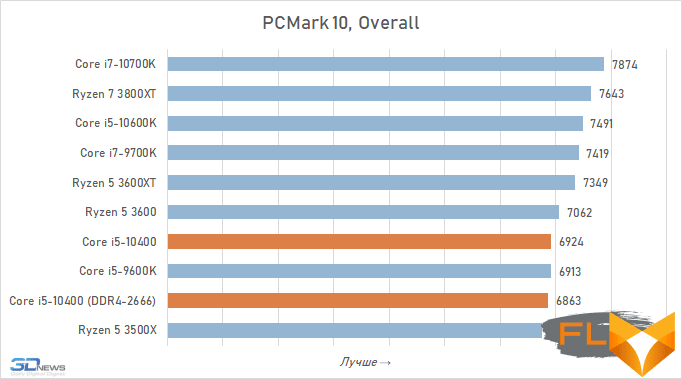
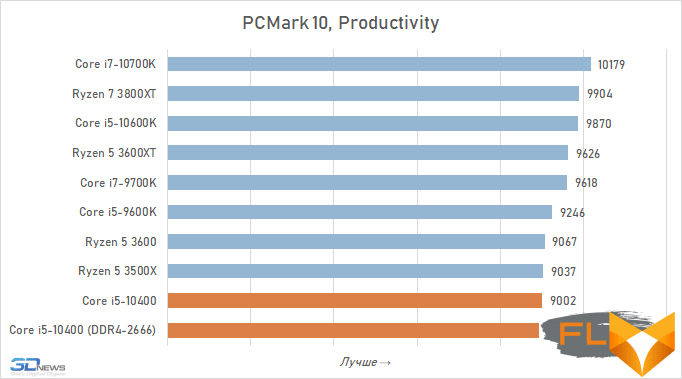
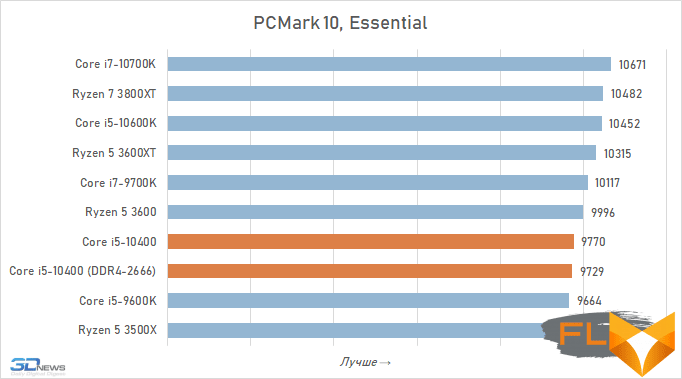
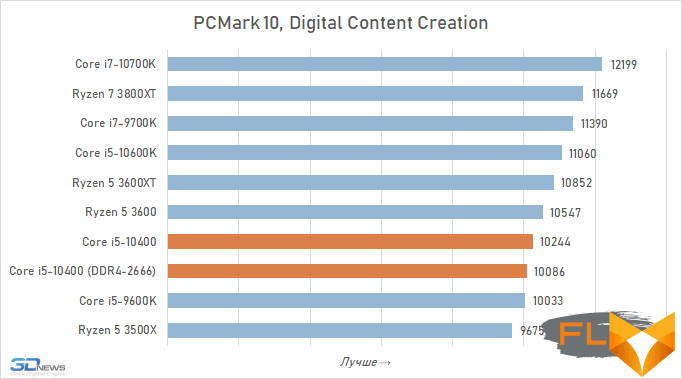
The situation in the 3DMark pseudo-gaming test looks better for the Core i5-10400. And in terms of processor performance, it even shows a higher result than its direct competitor, the Ryzen 5 3600. Moreover, the advantage of the Intel processor is preserved both when using “normal” fast memory and when paired with DDR4-2666.

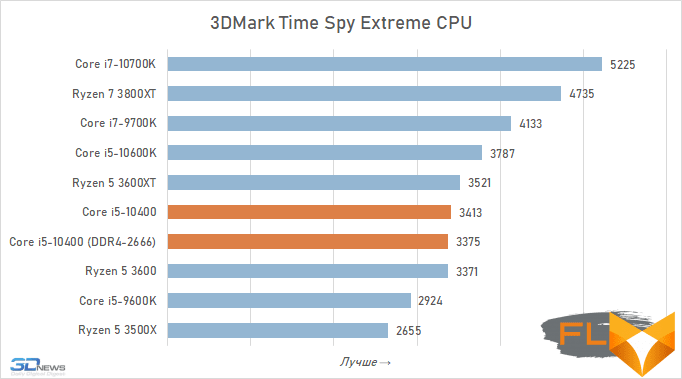
⇡#Application performance
If we talk about the proposals of AMD and Intel at a qualitative level, then it cannot be said that some of them have all the set of advantages necessary for unconditional dominance. In response to the fact that Zen 2 processors provide higher MHz-per-MHz and significantly larger caches, the Comet Lake family offers higher clock speeds and a highly efficient internal topology that ensures low latency in the memory subsystem and at inter-core interaction. However, specifically in the Core i5-10400, the main advantage of Intel processors is missing – this processor has a low clock speed in the vicinity of 4 GHz by modern standards. Therefore, in many resource-intensive tasks, the younger six-core AMD looks definitely better.
You don’t have to look far for examples. If we summarize the results shown by processors in ten applications from our test package, it turns out that the Ryzen 5 3600 outperforms the Core i5-10400 by a noticeable 10% on average. Only two cases stand out from the overall picture, where the Intel processor is still faster. This is archiving, where Intel solutions are traditionally strong due to efficient work with memory, and AI video processing in the Topaz utility, which is built on the Intel OpenVINO library, which has obvious optimizations for the Skylake architecture.
Nevertheless, the change in the core formula of the Core i5 processors that occurred during the transition from Coffee Lake to Comet Lake design can only be welcomed. Adding support for Hyper-Threading technology has made Intel’s latest CPUs much more competitive. This is clearly visible if we compare the results of the Core i5-10400 and Core i5-9600K: the older processor with six cores of the previous generation loses more than 15% in performance to the fresh Core i5-10400.
Another important observation concerns the fact that the use of the Core i5-10400 in motherboards based on the B460 chipset, which dooms it to work with frankly slow memory by modern standards, does not always lead to obviously negative consequences. Far from all programs suffer greatly from the lack of bandwidth of the memory subsystem, for example, only two of them were found in our test set: 7-zip and Lightroom. On average, owners of budget motherboards will lose about 3-4% in performance in resource-intensive tasks.
Rendering:

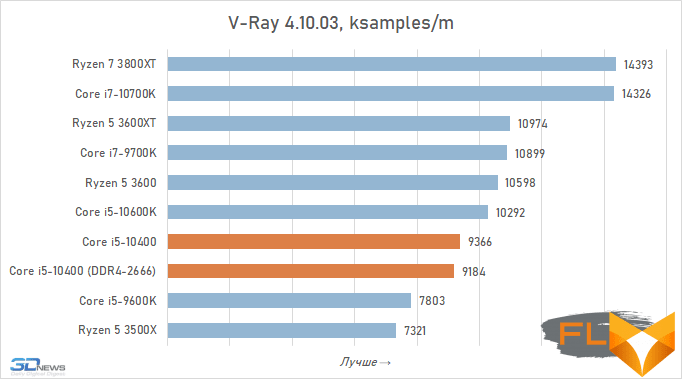
Photo processing:
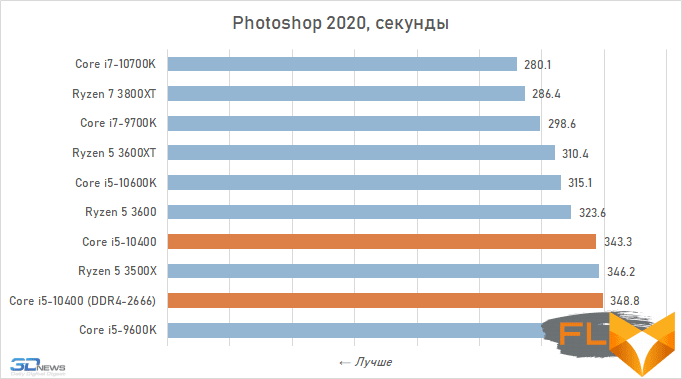
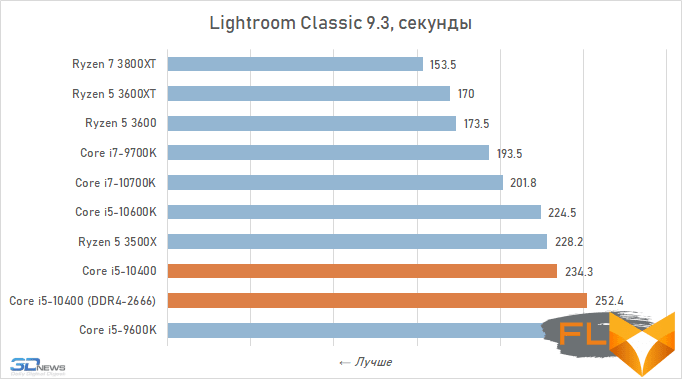
Video work:
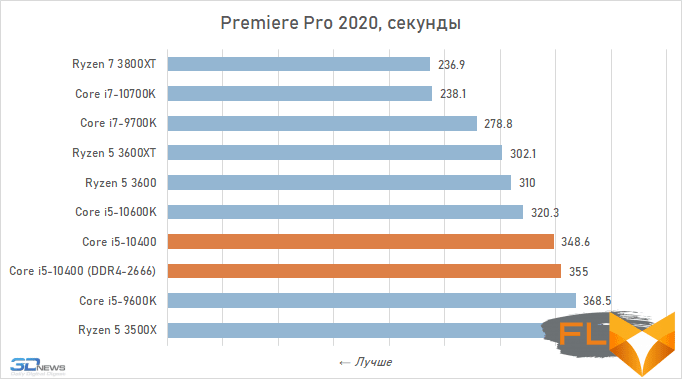
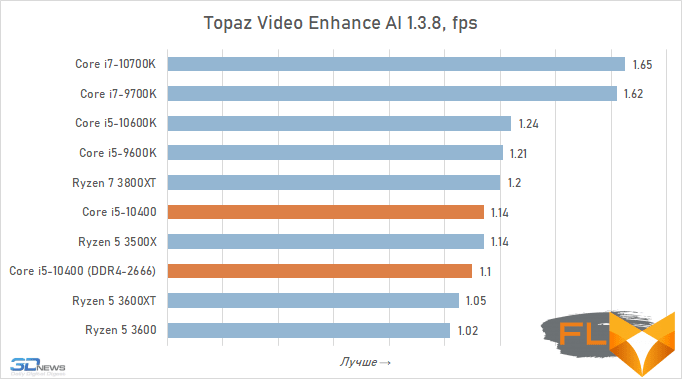
Video transcoding:

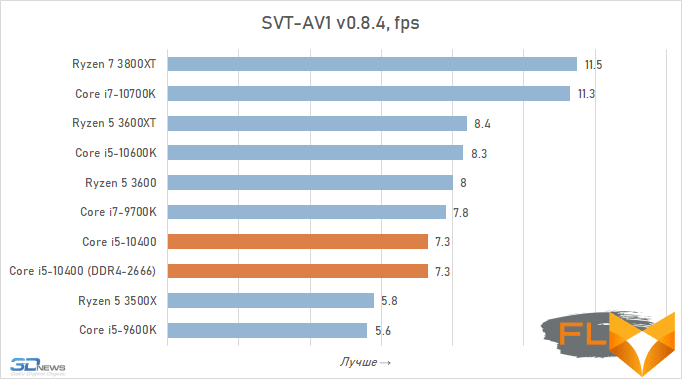
Compilation:
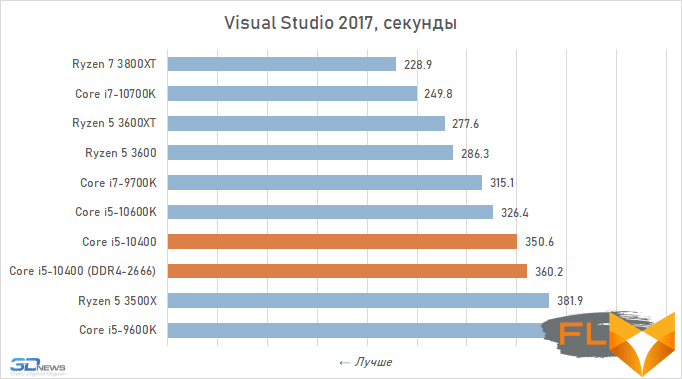
Archiving:

⇡#Tests in 1080p
Six-core processors are very popular for gaming builds, and the Core i5-10400 (or Core i5-10400F) has a pretty good reason to be one of the favorite options for budget gamers. A strong argument here is the price-performance ratio: the Core i5-10400 is about half as expensive as the eight-core Core i7-10700K, but in terms of average frame rates in games, it is only 10% inferior to it.
Until recently, inexpensive gaming configurations were customary to build on the Ryzen 5 3600, AMD’s inexpensive six-core processor, but the new Core i5-10400 looks frankly preferable. Intel added Hyper-Threading technology to its six-core processors, thanks to which they received a nuclear formula identical to Ryzen 5, nullifying their ideological trump card. And then the numbers speak for themselves: in terms of average FPS, the Core i5-10400 outperforms the Ryzen 5 3600 by 8%, and in terms of average minimum FPS, it wins by 10%. In other words, despite the loss in resource-intensive applications, the Core i5-10400 turned out to be stronger than the Ryzen 5 3600 in terms of gaming performance.
But here, unfortunately, not without a fly in the ointment. The Core i5-10400 outperforms the Ryzen 5 3600 in games, other things being equal, that is, assuming the same memory frequency is used. In the same case, if an inexpensive motherboard based on a different chipset from the Z490 is chosen for the Core i5-10400, it will have to be equipped with a slow DDR4-2666 SDRAM. And as follows from the results obtained, such an artificial deterioration in the characteristics of the platform is not in vain for the Core i5-10400. Gaming performance when switching from DDR4-3600 to memory with poor performance is reduced by 6-7%.
As a result, if we contrast the Ryzen 5 3600 with fast memory (and cheap Socket AM4 platforms do not impose any restrictions on the memory frequency) and the Core i5-10400 with slow memory, then the situation looks quite ambiguous here. On average, a slight advantage remains on the side of the Core i5-10400, but it cannot be said that it is convincing and sufficient to make the configuration with an Intel processor look preferable. Thus, in gaming systems built on the basis of inexpensive motherboards, there is a certain parity between the Ryzen 5 3600 and Core i5-10400, which arose only because of Intel’s inexplicable reluctance to unlock high memory frequencies in the B460 chipset (and at the same time in the H470 or H410).
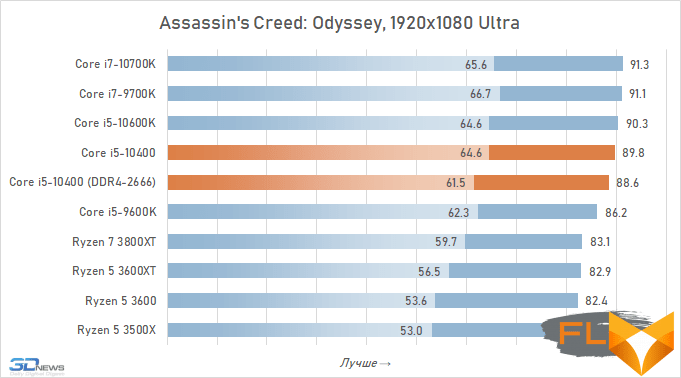


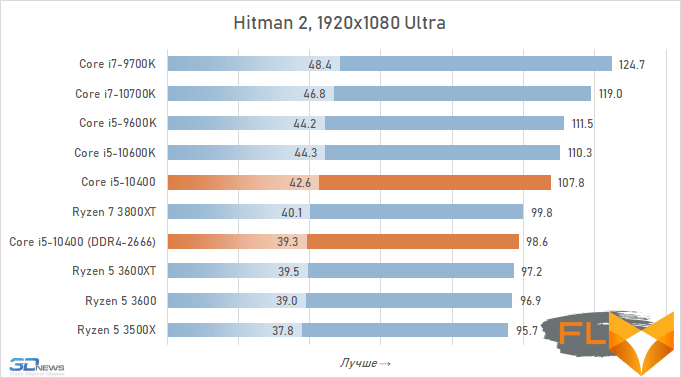



⇡#Tests in 1440p
There are no surprises when switching to a higher game resolution. The gaming performance figures here are somewhat closer due to the transfer of load from the processor to the graphics subsystem, but still the Core i5-10400 clearly demonstrates its superiority over the Ryzen 5 3600.
However, just like when testing in Full HD, here we again have to state that Intel “shot itself in the foot” by banning the use of high-speed memory in low-cost platforms. Therefore, in systems based on the B460, where the maximum memory frequency is limited to DDR4-2666 mode, the Core i5-10400 practically does not differ in gaming performance from its main competitor, the Ryzen 5 3600.
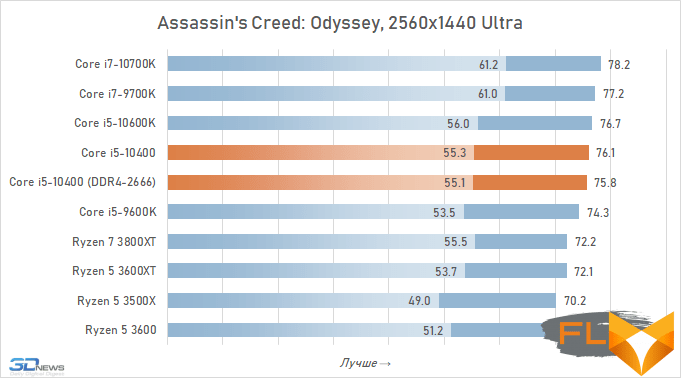
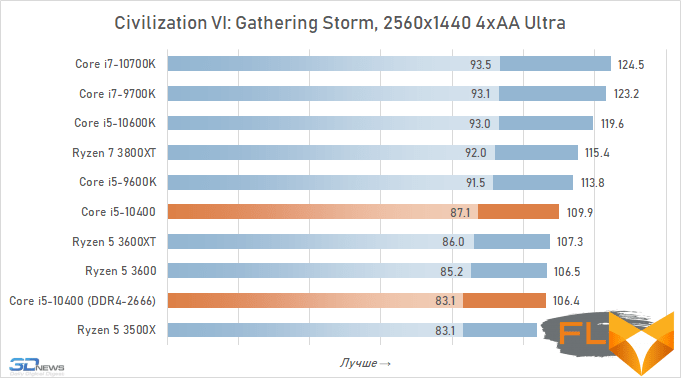
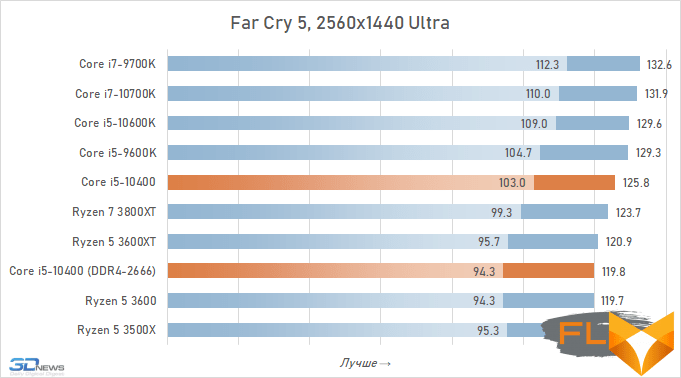
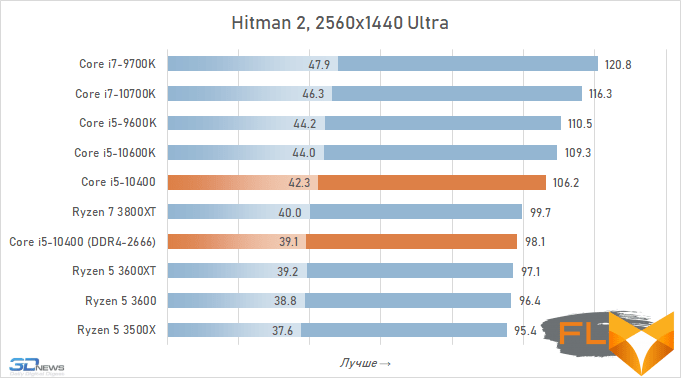
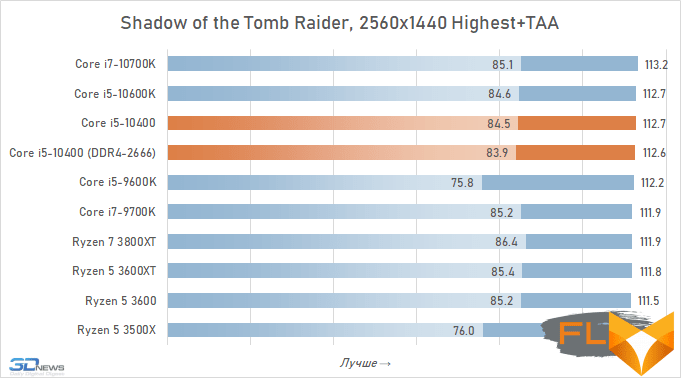
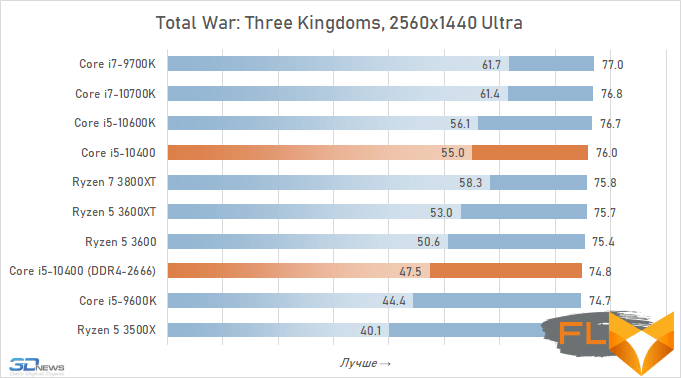
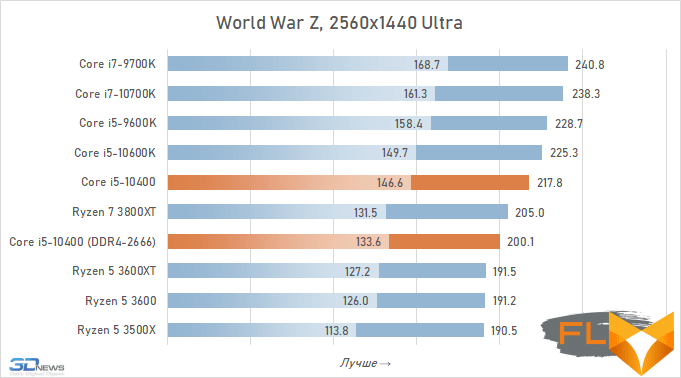
⇡#Power Consumption
Even when we tested the Core i5-10600K, it was noticed that modern six-core Intel processors do not differ in any exorbitant power consumption at all, despite the fact that they are manufactured using 14-nm technology. Considered today, the Core i5-10400 should be even more economical. It has a thermal package limited to 65 W, and it really fits into it – this has already been shown above, and in addition, it operates at a 500 MHz lower clock frequency.
Indeed, in practice, a system built on the Core i5-10400 turns out to be the most economical among all the options compared today. The graphs below show the total consumption of the entire platform (without monitor), measured at the output of the power supply.
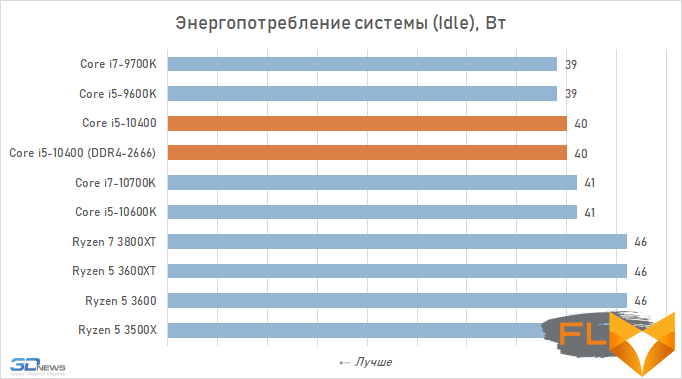
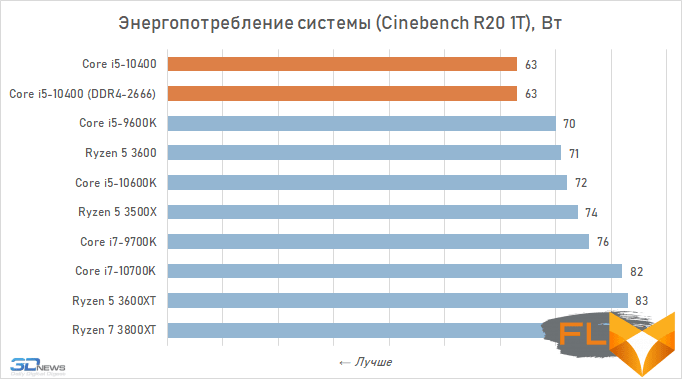

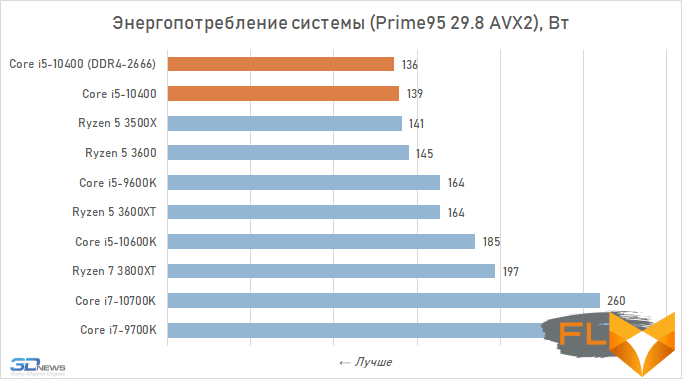
Especially significant is the consumption of systems observed when rendering in Cinebench R20. Although it looks a bit surprising, the Core i5-10400 easily outperforms any of the AMD processors in terms of energy efficiency, while modern Ryzen processors are produced using 7nm technology. And even with the AVX2 load in Prime95, at which Intel processors usually show exorbitant appetites, the Core i5-10400 requires less power than the Ryzen 5 3600.
From a practical point of view, all this means that the Core i5-10400 can definitely be recommended for use in compact systems. It does not need powerful cooling systems and spacious ventilated cases, and can also be used with low-power power supplies.
⇡#Conclusions
With the release of the Comet Lake generation processors, Intel has significantly improved its lineup, although they continue to use the older Skylake microarchitecture and are manufactured using the old 14nm process technology. Testing the Core i5-10400 made it possible to add another bright stroke to the overall picture, because the youngest representative in the updated Core i5 series was able to surpass the older processor of the same series, released a year and a half ago, by at least 15%. This was achieved in a completely understandable way – by adding support for Hyper-Threading technology, but this does not change the essence. In any case, progress is evident, and the most pleasant thing is that the performance and performance improvements have occurred in Intel processors without any price increase. As a result, the Core i5-10400, and especially the cheaper Core i5-10400F, becomes a very interesting option in terms of price and performance.
In fact, we can even talk about the fact that Intel managed to deal a very sensitive blow to the positions of AMD’s main bestseller, the junior six-core Ryzen 5 3600. On the one hand, as tests show, Ryzen 5 3600 is still a slightly faster solution for resource-intensive applications. But on the other hand, in games the Core i5-10400 wins a landslide victory, providing about a 10% advantage in frame rate (assuming a sufficiently powerful graphics card is used). Since gaming performance usually worries the average user much more, we can assume that the Core i5-10400 and Core i5-10400F have a good chance of becoming very popular models in the mass segment in the near future.
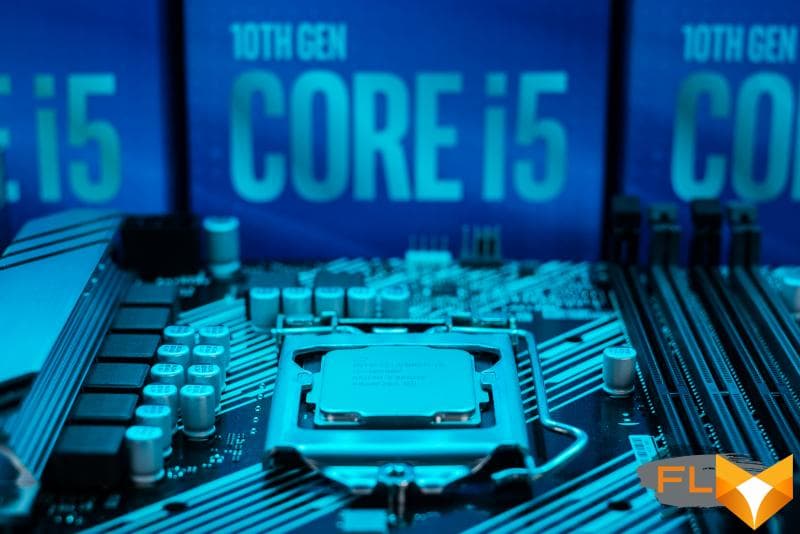
However, there is one unpleasant and insurmountable problem with building peppy gaming systems based on six-core Intel – there are no worthy inexpensive motherboards for them. The most affordable motherboards based on the full-featured Z490 chipset can match the cost of the Core i5-10400 and Core i5-10400F themselves, and their budget alternatives with the B460 chipset significantly cut performance due to the inability to work with faster than DDR4-2666 memory. All this leads to the fact that inexpensive configurations based on the Core i5-10400, in which there is no way to use full-fledged Z490 motherboards, will ultimately be almost no better than systems with Ryzen 5 3600 even in games.
But here, in appearance, one more weighty argument needs to be made, which is still capable of shifting sympathy towards the Core i5-10400F. The fact is that with this processor, Intel decided to use the favorite tactics of a competitor and compete for the attention of users with aggressive prices. As a result, the Core i5-10400F can be bought in stores today for about $50 less than the Ryzen 5 3600. For those who really care about raw CPU computing performance, such a discount is unlikely to force them to choose the slower “blue” option. But on the other hand, game lovers have an excellent opportunity to save money without any tangible losses. Therefore, until the price ratio changes, we will primarily recommend the Core i5-10400F for mid-range gaming configurations.
FAQ Core i5-10400 and core i5-10400f vs ryzen 5 3600 review
How does the Ryzen 5 3600 compare to the Intel Core i5-10400F in terms of gaming performance?
In gaming benchmarks, the Ryzen 5 3600 and the Intel Core i5-10400F offer similar performance, but the Ryzen 5 3600 may have a slight edge in some games due to its higher single-core performance.
Is the Intel Core i5 10400F compatible with DDR4 RAM and MSI B450 motherboards?
The Intel Core i5 10400F is compatible with DDR4 RAM but not with MSI B450 motherboards, as B450 motherboards are designed for AMD CPUs, not Intel.
What is the base clock speed of the Intel Core i5 10400F, and how does it affect its performance?
The base clock speed of the Intel Core i5 10400F is 2.9 GHz, which affects its overall performance, particularly in tasks that require consistent processing power over longer durations.
Between the Ryzen 5 5600X and the Intel Core i5 10400F, which offers better value for money?
The Ryzen 5 5600X typically offers better performance compared to the Intel Core i5 10400F, especially in single-core tasks, but it may come at a higher price. The 10400F is often considered good value for those seeking solid performance at a lower cost.
How do the Ryzen 5 3600 and the Intel Core i5-10400F differ in terms of multi-core performance?
The Ryzen 5 3600 generally has better multi-core performance compared to the Intel Core i5-10400F, making it a preferable choice for multi-threaded applications and tasks.
Can the Ryzen 3 3100 be overclocked to deliver better performance than the Intel Core i5 10400F?
The Ryzen 3 3100 can be overclocked due to its unlocked multiplier, potentially delivering better performance. However, whether it surpasses the Intel Core i5 10400F depends on the extent of the overclock and the specific workload.
In terms of memory support, is the Ryzen 5 3600 compatible with faster memory than the Intel Core i5 10400F?
Both the Ryzen 5 3600 and the Intel Core i5 10400F support DDR4 memory, but the Ryzen’s memory controller often allows for higher RAM speeds, which can benefit overall system performance.
Which CPU should I choose for better gaming performance, the Ryzen 5 3600 or the Intel Core i5-11400F?
For better gaming performance, the choice between the Ryzen 5 3600 and the Intel Core i5-11400F may depend on the specific games and benchmarks. Both CPUs offer excellent gaming performance, but user benchmarks and current prices should be considered.
How does the power efficiency of the AMD Ryzen 5 3600 compare to the Intel Core i5 10400F?
The power efficiency of the AMD Ryzen 5 3600 is generally comparable to the Intel Core i5 10400F, with both CPUs delivering solid performance per watt. However, the exact efficiency may vary based on the workload and system configuration.
Is the Ryzen 5 3600 a good choice for pairing with an Nvidia RTX 3060 GPU?
Yes, the Ryzen 5 3600 is a good choice for pairing with an Nvidia RTX 3060 GPU, as it provides enough CPU power to complement the GPU’s capabilities in gaming and other GPU-intensive tasks.
How does the AMD Ryzen 5 3600 compare to the Intel Core i5-10400F in terms of overall performance?
In a performance comparison, the AMD Ryzen 5 3600 typically offers similar or slightly better overall performance compared to the Intel Core i5-10400F, especially in multi-threaded applications due to its higher thread count.
What are the differences in single-core performance between the Ryzen 5 3600 and the Intel i5 10400F?
In terms of single-core performance, the Intel i5 10400F often competes closely with the Ryzen 5 3600, with Intel’s new core architecture sometimes providing a slight edge in single-threaded tasks.
How do user benchmarks for the AMD Ryzen 5 3600 vs Intel i5 10400F vary?
User benchmarks for the AMD Ryzen 5 3600 vs Intel i5 10400F show that while both CPUs are comparable in performance, the Ryzen 3600 generally pulls ahead in multi-core performance, making it a better choice for multi-threaded applications.
What is Tom’s Hardware’s view on the Ryzen 5 3600 vs Intel i5 10400F for gaming?
According to Tom’s Hardware, both the Ryzen 5 3600 and the Intel i5 10400F offer solid gaming performance, but the choice may come down to specific games and the rest of the system configuration.
Can the Ryzen 5 3600 handle modern games like PUBG effectively compared to the Intel 10400?
Yes, the Ryzen 5 3600 is capable of handling modern games like PUBG effectively, often delivering comparable performance to the Intel 10400, especially when paired with a capable GPU.
How does the 3.6 GHz AMD Ryzen 5 3600’s power consumption compare to the 2.9 GHz Intel Core i5 10400?
The 3.6 GHz AMD Ryzen 5 3600 and the 2.9 GHz Intel Core i5 10400 have similar power consumption, with the Ryzen often being slightly more power-efficient thanks to AMD’s 7nm manufacturing process.
In a performance test in benchmarks, which CPU shows better results, the Ryzen 3600 or the i5 10400F?
In performance tests and benchmarks, the Ryzen 3600 often shows slightly better results than the i5 10400F, particularly in multi-threaded tasks, though the difference can be minimal depending on the specific benchmark.
Should I go with Intel or AMD if I’m looking for a 6-core CPU like the Ryzen 5 3600?
Choosing between Intel and AMD for a 6-core CPU like the Ryzen 5 3600 depends on your specific needs. If you prioritize multi-threaded performance, the Ryzen 5 3600 is a strong choice, while Intel might offer better compatibility with certain applications and slightly better single-core performance.
What are the advantages of choosing a Ryzen 5 3600 over an Intel Core i5 from the 5000 series?
The Ryzen 5 3600, compared to an Intel Core i5 from the 5000 series, offers better multi-threading performance due to its higher thread count and can be a more cost-effective solution for those who need good performance but are also considering budget.
Is the Ryzen 5 3600 a good choice for users looking for a balance between performance and power consumption?
Yes, the Ryzen 5 3600 is an excellent choice for users looking for a balance between performance and power consumption, as it offers strong multi-core performance with a relatively modest amount of power draw.
